
Doc Savage and his crew employed technologies that were many decades ahead of their time. This was due to their access to highly advanced materials and concepts that were not available in the 1930s from mundane industrial sources.
The Super-Machine Pistol was a case in point. It was described as being larger than your average pistol and as having a "ram's-horn" magazine like the one below.

It could fire single shots or long bursts of fully automatic fire. It had a remarkable rate of fire between 700 and 800 rounds per minute. The sound this rapid-firing made was described like the roar of a bull fiddle. You can see a partial picture of this pistol on the Pulp cover of The Land of Terror above. In the picture, it seemed that the pistol had a drum magazine very much like that of a Tommy gun:

It could fire single shots or long bursts of fully automatic fire. It had a remarkable rate of fire between 700 and 800 rounds per minute. The sound this rapid-firing made was described like the roar of a bull fiddle. You can see a partial picture of this pistol on the Pulp cover of The Land of Terror above. In the picture, it seemed that the pistol had a drum magazine very much like that of a Tommy gun:
 There is description of this in the Super Saga Red Snow:
There is description of this in the Super Saga Red Snow:Doc Savage whipped away from the shuttered window, ran to his hand bag-the one from which he had taken the binoculars-and jerked up one of the flaps which separated the container into halves. This revealed five weapons which, one not knowing much about firearms, might have mistaken for automatic pistols.
Doc Savage removed one of these. Just ahead of the trigger guard, he clipped a magazine which resembled one of the reels on which film for home movie cameras is put up. Lying beside the unique weapons were five cylinders somewhat over an inch and a half thick and nearly a foot long. Doc affixed one of these to the muzzle of the over-sized automatic device, by a patent coupling.
Such a drum could carry up to 120 rounds of ammunition. You couldn't fit a pistol with that kind of drum in a shoulder holster or on our belt. But you could do so if you used a straight or curved magazine that held 20-30 rounds and then switched to the larger drum in a fire fight. I think it would have looked like the machine pistol below:

This next illustration is a visualization of the Super-Machine Pistol by Jim Steranko for a fanzine in the 1970s:

Steranko's reconstruction has a front handgrip that can swing down for more steady aiming using both hands. It also has interchangeable barrels which includes a silencer/flash suppressor as described in the quotation from Red Snow, and an extended barrel for increased effective range.
The Super-Machine Pistol appeared to use a small bullet -- likely a .22 caliber. We are also told that the usual type of bullet used was a "Mercy bullet" which was a hollow metal shell that contained a rapid acting anesthetic liquid. In Brand of the Werewolf, we are told that one mercy bullet had enough anesthetic to render an average 70 kg man unconscious for around 30 minutes.
A hollow-shelled bullet would not penetrate well at all, which was a positive thing in a non-lethal bullet. But it would still need to deliver its payload through the skin and into the bloodstream. I submit that the most likely anesthetic used was a ketamine derivative dissolved in Di-Methylsulfoxide (DMSO) solvent. If you touch DMSO to your little finger, you will taste it in your mouth in less that 30 seconds. Ketamine is a very rapidly acting agent that renders a person unconscious within seconds but does not suppress respiration or blood pressure. In fact it supports cardiac and respiratory function. Its effects last for about 20-30 minutes. It would be most effective if the mercy bullet penetrated the skin, but if you got this mixture on your clothing and it touched your skin, it would be rapidly absorbed and would still knock you out in just a few moments.
In the Super Sagas, they describe other types of bullets:
-Regular Ball ammunition
-Explosive bullets that could bring down "a small house"
-Tracer bullets that burn brightly and can be tracked with the naked eye day and night
-Incendiary bullets that could light fires on flammable targets
We can speculate about other types of ammunition as well:
-"Death Cap" ammunition: Just like a Mercy Bullet but with 100 mg of hydrogen cyanide dissolved in DMSO. Even getting the liquid on your skin from one bullet would be rapidly fatal. They were designed for special commando operations. The shells were pointed and designed to penetrate more deeply than mercy slugs. You could never confuse the two becasue they looked so different frm each other. Eventually "Death Cap" pistol rounds would become standard issue for designated U.N.C.L.E field agents
-Steel-Jacketed Ball ammunition: For military use. These would meet the requirements of the Geneva Convention.
-Hollow Point: Expands on impact to deliver a maximum kinetic pulse.
-Armor Piercing: Using a tungsten carbide or hardened steel core, these could penetrate light steel plates that were one-half inch thick. Effective even against most modern light body armor.
-Ultra High Velocity ammunition: Delivers more kinetic energy knock-down power than a .38 special round. In either ball, jacketed ball, or hollow point forms.
-Bird-Shot round: Fires a spray of smaller projectiles like a shot gun. Most useful for small game.
-Sabotted Flechette rounds: High velocity nail-like sabotted flechettes designed to penetrate between the fibers in a bullet proof vest or heavy clothing. These can be tinged with poisons. A drop of ricin toxin on one of these flechettes hitting anywhere in the chest or head would cause almost immediate death.
-"Memory" Ammunition: This is an exotic alloy bullet that has "memory". On impact, it "remembers" to expand itself into into an enlarged disc or lattice work shape that does extensive damage in side the body.
-"Smart" Bullet: An exotic alloy which remains hard when striking soft tissue but becomes soft on hitting a hard surface. This type of bullet does not expand in the tissues and is more humane than a hollow point. But it also will completely discharge its kinetic energy if it hits a wall preventing ricochets and further penetration. It is considered safer in a crowded urban environment.
-Piezoelectric Shock rounds: Based on the electric rounds invented by Hareton Ironcastle for the ill-fated Maple White Land expedition in 1918. The initial shock of the discharge in the pistol is converted partly into an electrical charge by the exotic alloy bullet and an electric discharge is released on impact into the target. It has an effect similar to a TASER. The shock is only ~10,000 volts, but it can knock a man out if you hit him just right with one round or in several places at once. The exotic metal alloy that Ironcastle first used was very heat labile, so he could not use a standard gun powder. Contrary to popular belief, gun powders do not explode. They combust rapidly releasing large amounts of hot gas that push the bullet out of the gun while the flame heats up both the gun and the bullet in the process. Ironcastle developed a "cold gun powder" that released large amounts of gas adiabatically without heating either the bullet or the gun. It produced no flash and gave off a popping sound instead of a sharp report. The rifle that fired this special shell was dubbed an "air gun" but this was a misnomer.
-Silent Ammunition: Used for special operations. Uses any kind of projectile with Ironcastle's "cold gun powder" and a silencer. The powder charge could be set for subsonic muzzle velocity which might obviate the need for the silencer.
ADDENDUM: During World War II, Doc redesigned his Super-Machine Pistol to fire a higher caliber 9mm round for use in military operations. The variant ammunition included mercy bullet, jacketed ball, armor piercing, explosive, piezoelectric, incendiary, tracer, and sabotted flechette. All of these rounds, except the tracers, also came in silent ammunition form. After the war, Doc reverted to the .22 caliber Super-Machine Pistols again.

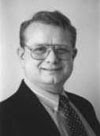

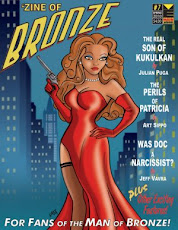
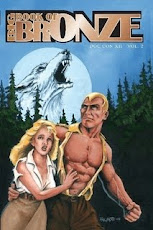



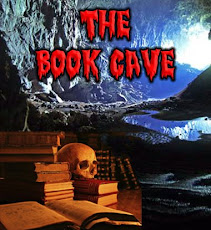


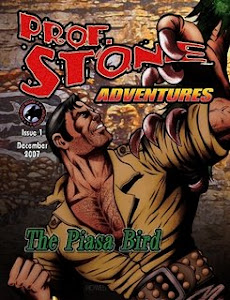


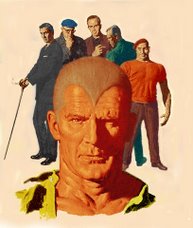

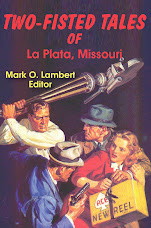
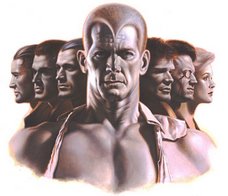


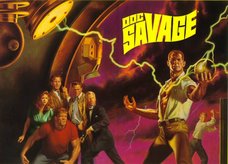





1 comment:
the closest you can come to,today would be the VZ-61 7.5mm submachine pistol that's Docs SMP also if you look at a airsoft website you will see a drum mag for the VZ-61 which could hold 40 7.5mm rounds. Thats my comment and I'm sticking to it. Iown a VZ-61 a shoot sweeter
Post a Comment